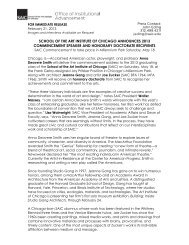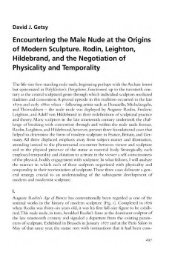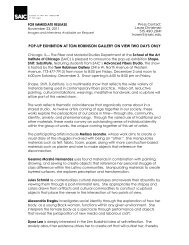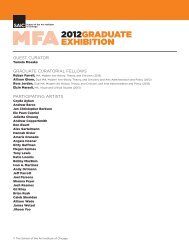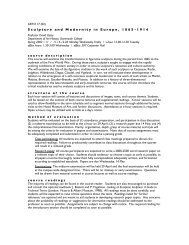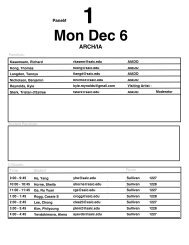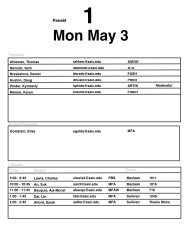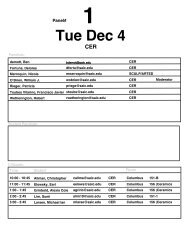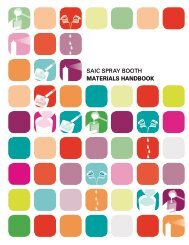i. institutional support and commitment to continuous improvement
i. institutional support and commitment to continuous improvement
i. institutional support and commitment to continuous improvement
You also want an ePaper? Increase the reach of your titles
YUMPU automatically turns print PDFs into web optimized ePapers that Google loves.
School of the Art Institute of Chicago<br />
Department of Architecture, Interior Architecture, <strong>and</strong> Designed Objects<br />
Master of Architecture<br />
Master of Architecture with emphasis in Interior Architecture<br />
II. EDUCATIONAL OUTCOMES AND CURRICULUM<br />
II.1. STUDENT PERFORMANCE CRITERIA<br />
1. Student Performance<br />
In response <strong>to</strong> feedback from earlier site visits regarding how the SPCs were delivered, the AIADO<br />
faculty adjusted their curriculum. Those adjustments can be seen in the matrixes on the two preceding<br />
pages. Regional accreditation verification, which is described below, can be found in Section IV.<br />
II. EDUCATIONAL OUTCOMES AND CURRICULUM<br />
2. Curricular Framework<br />
II.2.1. Regional Accreditation<br />
Approximately every ten years, SAIC undergoes a joint accreditation meeting from the School’s two<br />
institution-wide accrediting bodies: the Higher Learning Commission of the North Central Association<br />
of Colleges <strong>and</strong> Schools, the regional accrediting body; <strong>and</strong>, the National Association of Schools of Art<br />
<strong>and</strong> Design, the subject-area accrediting body. SAIC’s next accreditation visit will take place in 2012–13<br />
academic year. Copies of the letters conferring continued accredited status on SAIC follow the SPC<br />
matrixes, which are described above.<br />
II. EDUCATIONAL OUTCOMES AND CURRICULUM<br />
II.2. CURRICULAR FRAMEWORK<br />
II.2.2. Professional Degrees <strong>and</strong> Curriculum<br />
Begun in 2006-07, the MArch degree program housed within the AIADO department of SAIC was<br />
granted c<strong>and</strong>idacy by NAAB, effective as of January 1, 2007. The MArch degree program has four<br />
tracks in which qualified students may enroll <strong>to</strong> achieve the degree: the Master of Architecture track<br />
<strong>and</strong> Master of Architecture with Emphasis in Interior Architecture track—that each span 3½ years <strong>and</strong><br />
requires 102 credits—<strong>and</strong> the “Option II” variants on the two tracks, both of which usually take two<br />
years <strong>to</strong> complete. The Option II tracks both require 60 credit hours <strong>and</strong> take in<strong>to</strong> account particular<br />
work done at a previous pre-professional degree program. This previous work must substantially take<br />
the place of work that would normally be required in the first full academic year of the 3½-year tracks.<br />
Each track is described below:<br />
1) Master of Architecture<br />
The Master of Architecture program begins with a foundation of required skills <strong>and</strong> grounding in the<br />
his<strong>to</strong>ries <strong>and</strong> theories specific <strong>to</strong> architecture. In <strong>to</strong><strong>to</strong>, it is 102 credits earned from 30 courses (18<br />
Architecture studios, 5 art his<strong>to</strong>ry courses, <strong>and</strong> 7 electives) <strong>and</strong> typically takes three-<strong>and</strong>-one-half<br />
years. The program begins with an introduc<strong>to</strong>ry summer “boot camp” followed by three years of<br />
full-time study (15 credits) during the Fall <strong>and</strong> Spring semesters, <strong>and</strong> one summer study trip taken<br />
after the first year. The MArch’s thematic cluster of courses is integrated around a common intellec-<br />
tual theme, while each component class approaches the theme from a particular vantage point that<br />
reinforces the development of comprehensive underst<strong>and</strong>ing. The track begins with a foundation<br />
of required skills. Collaborative studios in the second year offer a chance <strong>to</strong> develop the transdis-<br />
ciplinary approach dem<strong>and</strong>ed by so many of <strong>to</strong>day’s situations. The third year studies culminate in<br />
the year-end Design Thesis Exhibition. To deepen the thesis research <strong>and</strong> experience, students are<br />
encouraged <strong>to</strong> enroll in elective courses from throughout the institution, including one that is “in the<br />
service of the thesis,” <strong>to</strong> advance <strong>and</strong> inform the thesis project.<br />
Each semester includes a conceptual cluster of classes with a 4.5-credit design studio—<br />
ARCH 5110 Architecture Studio 1: Sites<br />
ARCH 5110 Architecture Studio 2: Skins<br />
Architecture Program Report | 134



